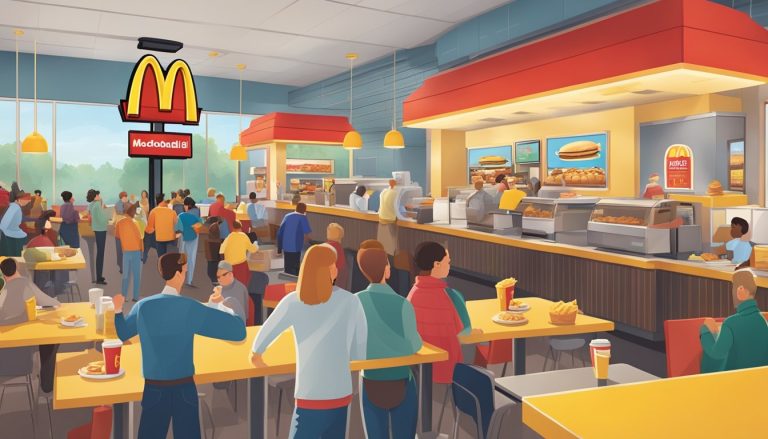McDonald’s breakfast menu has been a staple for many early risers since its introduction in the 1970s. While items like the Egg McMuffin and hotcakes are well-known favorites, the humble breakfast potato often flies under the radar. Yet these crispy, savory bites play an essential role in rounding out the morning meal offerings at the Golden Arches.
McDonald’s breakfast potatoes have an interesting history and undergo a unique preparation process that sets them apart from other fast food offerings. From the specific potato varieties used to the cooking methods employed, there’s more to these golden nuggets than meets the eye. Understanding the lesser-known facts about McDonald’s breakfast potatoes can give customers a new appreciation for this seemingly simple side dish.
1) Hash Brown History

McDonald’s hash browns have been a beloved breakfast staple for decades. The crispy potato patties were introduced to the menu in 1977, several years after the fast-food giant began experimenting with breakfast offerings.
The idea of serving breakfast at McDonald’s started in 1970 when franchisee Jim Delligatti received permission to sell donuts and sweet rolls during morning hours. This sparked interest in developing a full breakfast menu.
The Egg McMuffin, created by franchisee Herb Peterson, debuted in 1972 and became the cornerstone of McDonald’s breakfast. As the morning menu expanded, the company recognized the need for a potato-based side dish.
Hash browns were the perfect solution, offering a crispy, portable alternative to traditional breakfast potatoes. The iconic oval shape was designed for easy eating on the go, aligning with McDonald’s fast-food concept.
Since their introduction, McDonald’s hash browns have remained largely unchanged. Their popularity has made them a fixture on the breakfast menu, satisfying customers’ cravings for crispy, golden potatoes for over four decades.
2) Limited Locations

McDonald’s breakfast potatoes are not available at every restaurant. Only select locations offer this menu item, making it a rare find for many customers.
The availability of breakfast potatoes varies by region and individual franchise decisions. Some areas may have multiple locations serving them, while others have none at all.
This limited distribution creates a sense of exclusivity around the breakfast potatoes. Customers often seek out specific McDonald’s restaurants known to carry this coveted side dish.
The scarcity of breakfast potatoes has led to online discussions and forums where fans share information about where to find them. Some patrons even plan trips around visiting McDonald’s locations that offer this menu item.
Despite their popularity among breakfast enthusiasts, the company has not expanded the availability of breakfast potatoes to all locations. This decision may be influenced by factors such as regional preferences, kitchen equipment, or supply chain considerations.
3) Beyond Hash Browns
McDonald’s breakfast menu extends beyond its iconic hash browns. The fast food chain offers other potato-based options to satisfy morning cravings.
One alternative is the hotcakes and sausage meal, which comes with a side of crispy hash brown rounds. These bite-sized potato pieces provide a similar texture and flavor to the classic hash brown patty.
In some international markets, McDonald’s serves potato wedges as a breakfast side. These seasoned wedges offer a heartier alternative to hash browns while still delivering that satisfying potato taste.
Select locations have tested breakfast loaded fries, topping crispy French fries with egg, cheese, and bacon bits. This mashup combines McDonald’s famous fries with popular breakfast ingredients.
The chain has also experimented with breakfast potato croquettes in certain regions. These breaded and fried potato balls provide a unique twist on the traditional hash brown format.
While hash browns remain the star breakfast potato at McDonald’s, these alternative options showcase the restaurant’s efforts to diversify its morning menu and cater to different tastes around the world.
4) Potato Perfection
McDonald’s takes great care in selecting the potato varieties for their breakfast offerings. The fast food giant primarily uses four types of potatoes: Russet Burbank, Ranger Russet, Umatilla Russet, and Shepody.
These specific varieties are chosen for their ability to create the perfect texture and flavor in McDonald’s breakfast potatoes. The Russet varieties, in particular, are known for their high starch content and low moisture, which results in a crispy exterior and fluffy interior when cooked.
McDonald’s sources over 3.4 billion pounds of U.S.-grown potatoes annually for their various menu items. This massive demand has a significant impact on the potato farming industry, with McDonald’s fries alone accounting for approximately 7% of all potatoes grown in the United States each year.
The company’s commitment to potato quality extends beyond variety selection. McDonald’s has refined its cooking process over the years to ensure consistent results across its thousands of locations worldwide.
While the exact preparation method for their hash browns remains somewhat secretive, McDonald’s has been more transparent about their french fry process. This dedication to perfecting their potato products has helped maintain the popularity of McDonald’s breakfast offerings.
5) Iconic Pairings
McDonald’s breakfast potatoes have become synonymous with classic morning combinations. The crispy hash browns often accompany the Egg McMuffin, creating a satisfying duo of textures and flavors.
For those who prefer a heartier start to their day, the breakfast potatoes pair wonderfully with the Big Breakfast platter. This combination includes scrambled eggs, sausage, and a warm biscuit.
The potato side also complements McDonald’s hotcakes, offering a savory contrast to the sweet syrup. Many customers enjoy alternating bites between the crispy potatoes and fluffy pancakes.
Coffee and breakfast potatoes form another popular pairing. The bold flavor of McDonald’s coffee cuts through the richness of the fried potatoes, creating a balanced breakfast experience.
For those seeking a lighter option, the hash browns are often paired with fruit and maple oatmeal. This combination provides a mix of textures and nutritional balance to start the day.
6) Size Secrets

McDonald’s breakfast potatoes come in carefully controlled sizes. The hash browns are precisely cut to measure approximately 2 inches by 3 inches, ensuring consistency across locations.
For the newer potato offering, the cheesy potato bites, each piece is crafted to be roughly 1 inch in diameter. This uniform size allows for even cooking and a consistent customer experience.
The portion sizes of breakfast potatoes are also standardized. A typical order of hash browns weighs about 2 ounces, while a serving of cheesy potato bites contains 8-10 pieces.
McDonald’s uses specialized equipment to shape and cut their breakfast potatoes. This machinery helps maintain the exact dimensions and weights specified in their rigorous quality control guidelines.
The company’s commitment to size consistency extends to their packaging as well. Breakfast potato items are served in containers designed to fit the product perfectly, minimizing movement during transportation and preserving the intended presentation.
7) Late-Night Tradition
McDonald’s has long been a popular destination for late-night eaters seeking a quick meal. The chain recognized this trend and adapted its offerings to cater to night owls and shift workers.
In response to customer demand, McDonald’s introduced a dedicated late-night menu. This streamlined selection focuses on popular items that are easy to prepare during off-peak hours.
The late-night menu typically includes breakfast potatoes alongside other breakfast favorites. This allows customers to enjoy hash browns or other potato options outside of traditional breakfast hours.
Many locations serve breakfast items starting at midnight, blending late-night and early morning dining experiences. This practice has become a tradition for some customers, who specifically seek out McDonald’s potato offerings late at night.
While menu options may vary by location, the availability of breakfast potatoes during late-night hours has become an expected feature at many McDonald’s restaurants. This consistency has helped cement the chain’s reputation as a reliable late-night food option.
8) Crispy Technique
McDonald’s breakfast potatoes achieve their signature crispiness through a carefully crafted cooking process. The potatoes are first blanched to remove excess starch and sugars, creating a porous surface that allows for better oil absorption during frying.
After blanching, the potatoes are frozen. This step helps preserve their freshness and flavor while also contributing to the crispy texture when cooked. The freezing process causes small ice crystals to form within the potato, which create tiny gaps when they melt during frying.
When it’s time to cook, the frozen potatoes are fried in a blend of oils. The high heat quickly evaporates the moisture on the surface, resulting in a crispy exterior. Meanwhile, the interior remains soft and fluffy.
The frying time is precisely controlled to ensure consistent results. This attention to detail guarantees that every serving of McDonald’s breakfast potatoes has the perfect balance of crunch and tenderness that customers have come to expect.
9) Regional Variations
McDonald’s breakfast potatoes showcase intriguing regional variations across different countries and regions. In some U.S. states, the traditional hash browns may be replaced with local specialties.
Hawaii offers a unique twist, serving breakfast platters that include Spam and rice alongside potato options. This adaptation caters to local tastes and cultural preferences.
In certain international markets, McDonald’s adapts its breakfast potato offerings to suit regional palates. Some locations may serve roasted potato wedges or seasoned potato cubes instead of the classic hash browns.
Japan, known for its culinary innovations, has experimented with different potato preparations for breakfast menus. These may include specially seasoned potato patties or crispy potato bites with unique flavors.
European McDonald’s restaurants sometimes offer potato rösti, a Swiss-style potato pancake, as an alternative to hash browns. This demonstrates the brand’s flexibility in incorporating regional potato dishes.
These variations reflect McDonald’s strategy of tailoring menu items to local preferences while maintaining its core breakfast offerings.
10) Potato Quality

McDonald’s takes potato quality seriously for their breakfast offerings. The company selects specific potato varieties known for their flavor and texture when cooked.
Russet Burbank, Ranger Russet, Umatilla Russet, and Shepody are the primary potato types used by McDonald’s. These varieties are chosen for their ability to produce consistent results when prepared.
The potatoes undergo rigorous quality control measures before being accepted for use in McDonald’s breakfast items. This ensures that only the best spuds make it to customers’ plates.
McDonald’s sources its potatoes from trusted suppliers who meet strict standards. These partnerships help maintain the quality and consistency of the breakfast potatoes across all locations.
The company’s commitment to potato quality extends to its farming practices. McDonald’s works with growers to implement sustainable agricultural methods, ensuring a steady supply of high-quality potatoes for years to come.
11) Seasonal Offerings
McDonald’s occasionally introduces limited-time breakfast potato options to keep their menu fresh and exciting. These seasonal offerings often coincide with holidays or special events.
For example, during St. Patrick’s Day, some locations have offered green-tinted hash browns. This festive twist on the classic breakfast side adds a fun touch to the morning meal.
In select markets, McDonald’s has experimented with loaded potato bites. These crispy potato nuggets come filled with cheese and bacon, providing a heartier alternative to standard hash browns.
Some locations have tested sweet potato hash browns as a seasonal item. This variation offers a slightly sweeter flavor profile and different nutritional benefits compared to regular potatoes.
During fall months, certain McDonald’s restaurants have introduced pumpkin spice-seasoned breakfast potatoes. This limited-time offering capitalizes on the popular autumn flavor trend.
These seasonal potato options allow McDonald’s to innovate and gauge customer interest in potential new permanent menu items. They also create buzz and encourage repeat visits from curious customers.
History of McDonald’s Breakfast Potatoes

McDonald’s breakfast potatoes have been a staple of the chain’s morning menu for decades. These crispy hash browns evolved alongside the broader breakfast offerings, becoming a beloved side dish for millions of customers.
Origins and Evolution
McDonald’s entry into the breakfast market began in the early 1970s. Franchise operator Jim Dellegatti pioneered the idea of serving breakfast items during morning hours when most locations were typically closed. The initial focus was on coffee and basic breakfast foods.
Hash browns joined the menu as part of McDonald’s official breakfast launch in 1977. The company aimed to create a portable, crispy potato option that would complement their other breakfast items.
The recipe and cooking method for the hash browns were carefully developed to ensure consistency across all locations. McDonald’s partnered with major potato suppliers to secure a steady supply of high-quality potatoes for their new breakfast side.
Incorporation Into the Menu
McDonald’s breakfast potatoes quickly became a hit with customers. The hash browns were designed to pair well with other menu items like the Egg McMuffin and hotcakes.
As the breakfast menu expanded, hash browns remained a constant. They became an optional side for breakfast combos and a popular à la carte item.
McDonald’s sources billions of pounds of potatoes annually for its various potato products, including breakfast hash browns. The company’s massive scale has a significant impact on the U.S. potato industry, with McDonald’s fries alone accounting for an estimated 7% of all potatoes grown in the country each year.
Nutritional Information and Ingredients

McDonald’s breakfast potatoes contain a mix of nutrients and carefully sourced ingredients. Understanding their nutritional profile and ingredient quality provides insight into this popular menu item.
Caloric Content and Nutritional Value
McDonald’s hash browns contain 140 calories per serving. They provide 9 grams of fat, 15 grams of carbohydrates, and 1 gram of protein. The sodium content is 310 milligrams, which is 13% of the recommended daily intake.
These breakfast potatoes are a source of vitamin C and potassium. They contain no artificial colors or flavors. The fat content comes primarily from the oil used in the cooking process.
While not a low-calorie option, hash browns can be part of a balanced breakfast when consumed in moderation. They pair well with protein-rich choices like eggs or yogurt.
Ingredient Sourcing and Quality
McDonald’s uses high-quality potatoes for their breakfast items. The main ingredients are potatoes, vegetable oil, salt, and corn flour. Dextrose, a form of sugar, is added to maintain color consistency.
The company sources potatoes from approved suppliers who meet strict quality standards. These suppliers follow sustainable farming practices and food safety protocols.
McDonald’s has committed to using non-GMO potatoes in their products. They also work to reduce pesticide use in their supply chain. The oil used for frying is a blend of canola and soybean oils, chosen for their nutritional profile and cooking properties.




